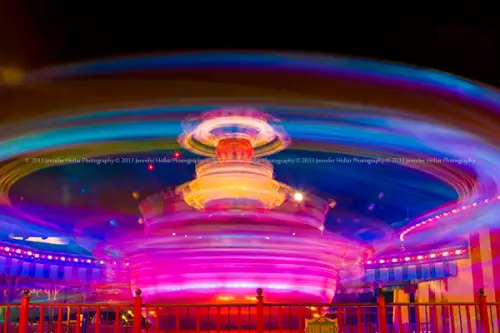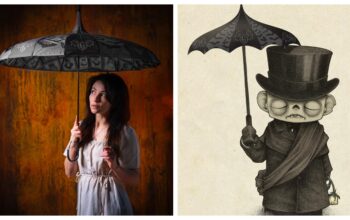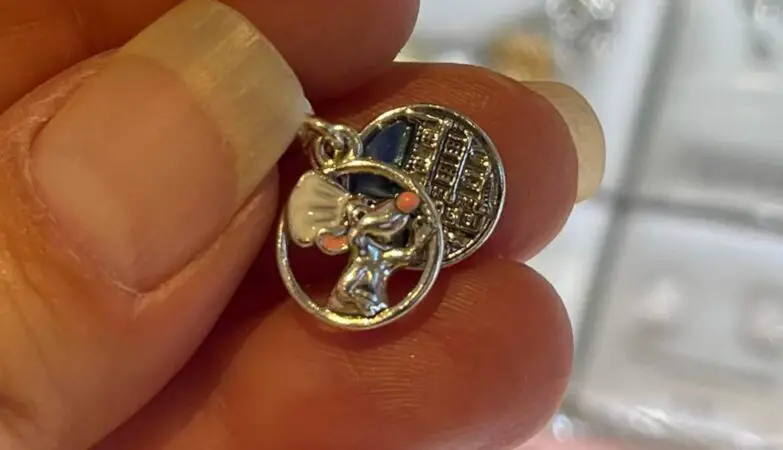Disney Night photography is one of the hardest types of photography to master, especially when you don’t have control over the elements. I’ve been a professional photographer for more than three years now and am always learning new techniques and tricks to help perfect those night photos. Here are some basic tips to make your night photos better when visiting Disney World – for those with a regular digital camera and those with a dSLR.
I’ll first start with tips for those who don’t own a dSLR and just have a digital camera. Unless you have the highest megapixel and most awesome camera phone, then put your camera phone away. If you’re just posting the photos to Facebook or other social media, then snap away with the phone. But if you’re planning on having the photos printed or displayed in a larger size, then a phone’s camera just won’t cut it at night.
If there is a cardinal rule that everyone should follow, it is – don’t use your flash to get those night photos! This goes for dark rides as well – there’s a reason why they say ‘please, no flash photography’ before you start out on a ride. Not only does it ruin the experience for other guests (not to mention it’s VERY rude and distracting), it also highlights parts of the ride that are never meant to be seen. And it makes your pictures look pretty bad. That small fill flash on your camera isn’t really going to help illuminate anything but what’s in the 10 ft in front of you – so it won’t help illuminate the entire castle if you’re 100 ft away…and if you have a nice external flash on your dSLR, then you also know (or you should know) that it will only illuminate so much as well, so it’s not very helpful with capturing things that are at a distance. Now if you’re just taking a photo of a person or just trying to concentrate on what’s within a few feet of you, then you can use a flash, but know that your background will be dark and the faces of those you’re taking a photo of may be washed out since you don’t really have much control over the power of your flash with a regular digital camera.
Another good tip for anyone, regardless of what camera you’re using – use a tripod. Night photography requires a steady hand or tripod in order to avoid the blurry/shaky pictures. Don’t have a tripod? Then use something that’s sturdy around you, like a trash can or wall. I didn’t have a tripod with me for our last trip, but I was able to get some pretty awesome pictures by simply using a trashcan nearby to sit the camera on.
Use a shutter release remote so that you’re not touching the camera once you have it setup. By doing this, you minimize any shake that may occur if you’re pressing the shutter button on the camera yourself. These can be purchased pretty cheaply at any store that sells cameras or equipment and will usually work for digital cameras and dSLR’s.
Unfortunately, if you don’t have a dSLR with a lens that allows you to get set it at f1.8 or below, you won’t be able to capture the true lighting of a dark ride without encountering blur or a lot of noise. The rides are moving and they’re dark, a tricky combination to work with. You can get decent pics with a lens that allows you to go down to an f2.8 setting, but they will still be a bit dark or noisy. You can purchase a Canon or Nikon lens that adjusts to f1.8 pretty cheaply – for under $125! If you only shoot in auto mode, then this probably won’t help you very much unless your camera automatically adjusts the aperture down to the lowest possible setting to capture the light of the ride. If you have a dSLR and don’t know what f1.8 or apenture means, then bring out that owner’s manual for your camera or watch some YouTube videos and start learning how your camera really works so that you can take advantage of all it has to offer. Shooting in auto mode is not going to help you capture the best photos at night unfortunately and only limits how great your photos can truly be.
So how do people take those pretty photos where the fireworks look like they were captured over time, yet the castle is still in perfect focus? Well, it requires a tripod (or trash can) and knowing how to create a long exposure picture. I took on a personal photography project back in April while at Disney World and focused solely on night photos – I have to focus on one thing or else I’ll end up with 2000 pics for the week-long trip that takes me a year to get around to editing. The above picture was my first attempt at a long exposure photo and if you can’t tell, it’s a photo of the Dumbo ride – the fence is in focus at all times, but the camera is capturing the motion of the ride over a set period of time – it would work the same way with fireworks. Since I didn’t have a tripod, I just set my camera on a trash can. I also didn’t have a shutter release remote with me that trip, but was still able to capture the picture. For this photo, I had my old Canon T2i, used a Canon 24-70mm f2.8 lens and the settings were: 24mm focal length, 10 second exposure, f/22 and the ISO was set to 400 since I was keeping the shutter open for so long. I haven’t talked about ISO yet, but the higher the ISO, the more ‘noise’ you’ll see in your photo since it’s making your camera’s sensitivity to light higher – some cameras can go all the way up to ISO 6400, but that’s not always a good thing I’ve found and I try to never go over ISO 3200 if you’re going to adjust your ISO settings. ISO also affects what your f-stop and shutter speed should be, so be careful when setting the ISO, or just keep it on auto and hopefully it will adjust correctly. Moving things are a bit more tricky, but it’s much easier to capture something that’s moving if you’re staying stationary and have your camera on a tripod than if you’re say in a boat at Downtown Disney trying to capture the shoreline.
I’ve since upgraded to a Canon 5D Mark II and will be using that on the next trip to get even sharper photos, but you don’t have to spend a whole lot of money on a dSLR to get great photos. They have entry-level ones for under $600 that are great for beginners and some even shoot HD video, like the T2i. There are also several companies out there that rent camera lenses and camera bodies, so be sure to check those out as well if you just want to ‘try before you buy.’ The most important thing is to really get to know your camera BEFORE you leave for your trip, so be sure to practice a lot before you go so that you’re prepared. You may not get those photos that you’re hoping to get right away, but even as a professional, I don’t always get them the first try and I just keep adjusting my settings until I’m able to get exactly what I want.
And believe it or not, most photographers don’t get those ‘incredible’ looking pictures straight out of the camera, although it is possible and not everyone tweaks their pictures to the point where they look way too Photoshop’ed. It requires us to use programs like Adobe Lightroom or Photoshop in order to adjust certain parts of the picture – like exposure, contrast, white balance, and maybe the vibrancy of the colors. I made very few adjustments to the above picture and really only added a bit more light to the photo so that the colors weren’t too dark. I also only shoot in RAW, which means that the camera captures more information on the photo so that it can be adjusted (such as exposure), versus shooting in JPEG mode which doesn’t retain as much information and hinders you from making some needed adjustments at times. But if you’re just starting out, definitely shoot in JPEG until you have software that can handle RAW camera formats and a larger hard drive since RAW files are pretty large files. Lightroom is pretty cheap and can be purchased for under $150 and you can frequently find Photoshop Elements (for beginners) for under $100 – or if you really want to go all out, it’ll set you back several hundred dollars for a version of Photoshop CS.
I could really go more in-depth about camera settings, as there is A LOT more to learn if you’ve never conquered shooting in manual mode on your dSLR, but that would probably be too overwhelming for most of you and what non-photographer really wants to read an article with a bunch of technical jargon that seems like greek – although I’m sure the last half of this article was probably foreign to some reading it? Hopefully this will help you plan and prepare for your next trip to the parks so that you can make the most of your photos taken during fireworks, dark rides or just the beautiful landscape of the parks at night. If you have any questions for me about night photography or just photography in general, just comment below and I’ll try my best to answer your question.
To keep up with my latest work, be sure to visit my Facebook page or visit my website.

Let our friends at Destinations to Travel help you book your next Disney Vacation. They are the preferred Travel Agency of Chip and Company and Disney Addicts, and who we use ourselves.
Get started below for your FREE No Obligation Quote.
Book With our friends at Destinations to Travel
For the BEST in Disney, Universal, Dollywood, and SeaWorld Theme Park News, Entertainment, Merchandise & More follow us on, Facebook, Instagram, and Youtube. Don't forget to check out the Chip and Company Radio Network too!









I am glad that you have explained the whole guidelines keeping not only dSLR but also digital camera in mind. I was not aware of that shutter release remote, thank you for mentioning such a helpful trick here. This shutter release remote is really cool and helpful for all, specially for the photography beginners.
That’s true as well, but can be a bit time consuming since you have to reset it each time. Remote releases are really cheap – we picked one up recently for only $3 on clearance at Target 🙂
Something else I would suggest if you don’t have a remote release then just use your timer function on the camera. Set it on something not moving and stable and then use a quick timer on the camera so you are not touching it when the shutter is released.